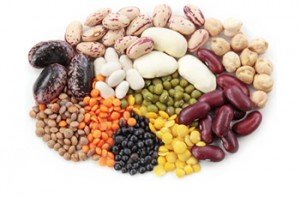
Legumes often get a bit of a bad rap, and mostly because they induce a rather nasty side effect that often could see us power a small third world village. But despite this ugly side of beans this ‘musical fruit’ does actually have a lot of benefit and can actually aid weight loss when prepared and consumed in the right manner.
Renewable Wind Power
OK, let’s deal with the gassy side of beans first. Beans tend to cause wind in people because of their oligosaccharides – a group of sugar molecules in beans that provide natural sweetness. Most sugar molecules when consumed are processed and pass through the intestinal wall of the stomach prior to reaching the large intestine (that’s the short but thick one that’s connected to the stomach).
However oligosaccharides are too large to pass through the intestinal walls and it turns out our stomach doesn’t have the right enzymes to digest these molecules into smaller pieces which can then be absorbed. So they reach the large intestine and meet up with over 700 species of bacteria which then go on a sugar feeding frenzy, producing hydrogen, methane and other gases as by-products of their metabolic activity, and “hey presto” your bottom begins to burp.
Avoiding a Gas Explosion
The answer is to choose varieties with low amounts of oligosaccharides – these include lentils, adzuki beans, mung beans, black eyed peas, split peas, peanuts and organic soy beans. Avoid high oligosaccharide beans like black beans, kidney beans, navy beans, pinto beans and chick peas (which means hummus too).
And once you’ve chosen your bean, soak it in water prior to cooking as some of the oligosaccharides will move out of the legumes and into the water. Soaking the legumes in water at least overnight will also reduce cooking time and improve the texture. For best result soak the beans for 24 hours and change the water every 8 hours.
The best method for reduce gas is to rinse the soaked legumes and put them in a pot 1 part legumes to 2 parts water. Bring to the boil for about a minute, then drain and rinse in cold water. Repeat this twice more to minimise the oligosaccharides left in the beans. Then you can cook them until they are tender – simmer for up to 90 minutes.
And if you’re taking a shortcut and using canned beans, the same rule applies – whilst they tend to produce less gas they do have added sodium. So soak them overnight prior to eating to alleviate both issues. You’ll be amazed at what comes out!
And if after all this you’re still not getting a gas-free experience then you can buy a natural enzyme, ‘vegan beano’ to help break down the oligosaccharides in legumes.
Beans for Weight Loss
OK let’s talk nutritional benefit. Why does everyone hail legumes as an important weight loss staple? It’s really because beans are complex carbohydrates (so they’re low GI) with a relatively high amount of protein and fibre, making them a sort of ‘all round’ food. And they’re packed with some really good vitamins and minerals like folate, zinc, iron and magnesium. And dark red beans are high in antioxidants which help curb your fat cravings and help prevent cancers by soaking up free radicals.
And there’s been a lot of research that concludes enjoying half a cup of cooked legumes of choice each day can help lower cholesterol and fight heart disease. So adding beans in your diet can be a good way to balance your food groups and aid in your weight loss journey. And they’re great in salads or stews.
One Last Cautionary Tail
So there’s just one more thing you should know about beans. Beans do contain lectins – specific proteins that bind to carbohydrates. It’s mother nature’s protection mechanism and lectins are basically present in all plant matter in varying degrees. And it’s interesting to note that foods with the highest lectin content are actually grains, especially wheat.
Lectins when consumed in low levels are nutritionally beneficial. But when they are consumed in excess they are capable of harming the lining of the human intestines, especially the microvilli, through which they can escape. Whilst it’s unlikely to occus, once in the blood stream they can bind with any carbohydrate containing protein cells, including insulin and leptin receptors, and your metabolism can be affected.
The best way to reduce the lectin content in beans is by soaking, fermenting and sprouting. And minimise the consumption of unnecessary lectin in your diet from sources like processed grains, particularly wheat.

